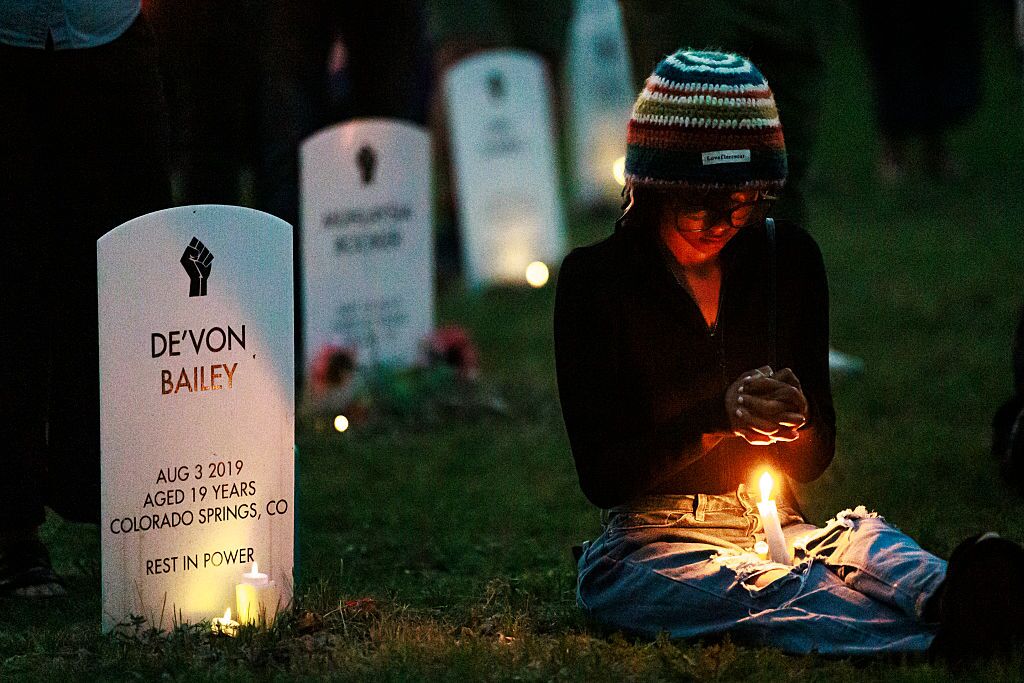
GOP Lawmakers Are Hitting a Roadblock on Tax Cuts
May 13, 2025
Antigovernment leader Ammon Bundy loses pandemic-era court case in Idaho
May 13, 2025Led by Elizabeth Rhodes, OpenResearch’s Unconditional Cash Study explores how direct monthly payments of $1,000 can impact employment, well-being and opportunity for low-income Americans.
How transformative would an extra $1,000 a month be for low-income Americans? That is the question that OpenResearch, started by the founder of OpenAI Sam Altman, set out to answer with its three-year Unconditional Cash Study. Participants were given $1,000 per month with no strings attached, and their experiences were compared against a control group that received $50 per month.

The study’s director, Dr. Elizabeth Rhodes, sat down with Ms. contributor Michelle Onello to discuss the study’s findings and how cash transfers can help inform government policy to alleviate poverty.
This interview has been lightly edited for length and clarity.
Michelle Onello: Can you describe OpenResearch and how you got involved with the study?
Elizabeth Rhodes: OpenResearch is a nonprofit research organization designed to look at open-ended, longer-term questions that for-profit companies and academic institutions may not be best suited to explore.
The project I lead, the Unconditional Cash Study, is our biggest project.
Originally, Sam wanted to find ways to mitigate AI-related job losses. My work explored the existing social safety net, focusing on how to better support low-income individuals and families. I had written a paper revisiting the negative income tax, so the idea of experimenting with cash transfers was exciting.
We were given autonomy and flexibility to think holistically about designing a comprehensive study. We wanted to understand the benefits of unconditional cash, but also the barriers limiting the ability of cash to provide agency. We recruited individuals ages 21 to 40 who were more likely to have kids and be making career and mobility decisions. We wanted a diverse group so recruited from urban, suburban and rural areas and ethnically and racially diverse populations.
The cap was 300 percent of the federal poverty level, but we had three different income groups—low, middle and high, relative to the federal poverty level—and we over-sampled at the lower-end, meaning $12,490 or less annual income for a single person. We drew from Texas and Illinois, with the existing social safety net and policy environment in Illinois more generous compared to Texas. We had 3,000 participants but also 156 qualitative participants that we interviewed six times, sometimes for up to five hours.
Onello: How were participants selected?
Rhodes: We didn’t make a public announcement. We used mailers in low-income areas, targeted ads on Facebook and an app that SNAP recipients use to manage benefits. Lower-income people tend to be female, so we aimed to reflect the eligible population. Our goal was to get as random, but also as representative, a sample as possible.
Onello: Can you give me a snapshot of your preliminary findings, including employment? Some critics warn that cash transfers disincentivize work—was that true?
Rhodes: Everyone given a housing voucher uses it for housing. But for 3,000 people, there are 3,000 different stories.
Someone’s father had just died from COVID and she couldn’t afford the funeral expenses. Another had finished cosmetology school but couldn’t afford the license. Another had been in a car accident, and yet another had been diagnosed with cancer.
Immediately we saw the cash going in different directions, and I underestimated how much variation there would be and how that makes drawing overall conclusions challenging.
Regarding employment, we saw an increase in the intrinsic value of work. People want to support themselves, but what if they don’t have transportation? What if that extra dollar earned means they lose childcare benefits? We saw small reductions, about 2 percent or 1.3 hours per week, in employment. Participants at the higher income levels cut back their hours, whereas, at the lower income levels, it’s not enough money to do that. And it’s largely single parents who were working less. There are value judgments focusing only on the number of hours worked. Do we care that single parents are working a few hours less and spending more time with their kids?
Cash allowed some participants to be more selective about finding a job to fit their needs. One single mom participant was a phlebotomist with no opportunities for growth, so she found a lower paying job with higher growth potential. She couldn’t have afforded a pay cut without the extra money. Now, she is salaried and has gotten three promotions. Another participant was able to join a job training program.
We also saw a big interest in entrepreneurship—strongest for women and Black participants.
Do we care that single parents are working a few hours less and spending more time with their kids?
Elizabeth Rhodes
Onello: Was your data disaggregated by gender? Were there specific gender-related impacts?
Rhodes: We are disaggregating by gender, and see differences in employment by gender. For males, the employment rate actually goes down more, but for women, the earned income goes down. Women are working, but they’re not earning as much. Women are taking lower-quality jobs on paper that are flexible so they can, for example, spend more time with their children.
Onello: How did you determine what participants were doing with that extra time?
Rhodes: Our qualitative data is so helpful and we collected time diary data. Time diaries are difficult, especially for women and parents who are multitasking. But we did see families spending more time together. For those under 30, we saw increased enrollment in post-secondary education, even after the transfers ended. Just as participants spent cash in many different ways, they did many different things with their time.
Onello: Were there different outcomes in rural, suburban and urban areas?
Rhodes: There were differences, but we have to be careful not to overinterpret data. We see reductions in evictions and a concentration of material hardship reduction in rural areas. We see reductions in some types of self-reported drug use, like using painkillers not prescribed to you or dangerous alcohol use, and that was concentrated in rural areas.
Onello: Some cash transfer critics have warned that participants will spend the money on drugs or alcohol.
Rhodes: Critics of cash transfers argue that people will not spend the money in socially optimal ways, but participants spent to meet their basic needs.
During enrollment, we asked about alcohol and drug use, but we did not screen for it or drug test. But a few participants in the qualitative study were struggling with addiction at the beginning. One reported that she at first continued using drugs, but then realized this was her shot to finally stop and regain custody of her kids. She was living with other addicts, and it was hard to change her life. She now has custody again and has a job.
There are several participants who said a lump sum at the beginning would not have been good, but a piecemeal approach gave them stability over time.
Onello: Were there any differences in spending between the lower, middle and higher-income cohorts?
Rhodes: Spending on food, housing, transportation and basic needs increased for the whole sample, but was particularly strong for the lowest income group. $1,000 a month is a lot, but is not a lot when you can’t afford very basic needs or are unhoused.
For the middle income group, they spent more on rent.
At the higher income, it wasn’t concentrated in any particular category—they were already meeting basic needs so had more choices regarding how to spend.
There are some very transformative stories and some “I was able to buy shampoo” stories.
Onello: You launched during COVID—how did that complicate the study?
Rhodes: We started in-person enrollment in fall 2019, and were about half enrolled prior to March 2020. We then began enrolling participants by phone so had a half and half balance. When we did our randomization in October of 2020, we made sure to balance control and full participants across both pre- and post-COVID enrollment.
We sent out monthly web-based surveys as we were enrolling the second half, so we collected data on COVID’s impacts on employment, for example. Many participants worked in the service industry and were unemployed. For people with kids doing remote schooling, the money changed the calculus on when and how to reenter the labor market.
COVID also impacted expenditures since participants were generally spending less initially because they were home. We saw healthcare expenditures go up but some participants were initially on Medicaid and then got a job with much more expensive health insurance and higher deductibles, particularly in Illinois rather than Texas where Medicaid eligibility is restrictive.
Onello: How do the study findings translate into policy recommendations?
Rhodes: No single policy will provide a solution to the challenges of poverty and growing inequality which will require a more robust policy framework to solve. Cash is part of the solution because it gives flexibility and agency but it’s not a silver bullet.
We have an enormous volume of data but a really small team, so exploring the larger policy framework is ongoing. One single mom participant said that policymakers need to know her reality and the choices she is facing so they can make better decisions. Our study showed the nuance and complexity of people’s lives so we will continue to dig into the data so we can provide policymakers better information.
Life is more nuanced and complex than simple indicators, so we need studies to understand the details and nuances. Our study can help to understand people’s lived experiences and collectively shape the future.
Elizabeth Rhodes
Onello: Do your findings align with other studies about universal cash transfers?
Rhodes: There is alignment, though ours was much larger. In some situations, cash transfers are transformative, and in others they’re less so. Participants for whom it was more transformative longer term generally started off in a better place. We need to use the data to ensure that it’s more transformative for more people.
Onello: Are there plans to check back with participants?
Rhodes: The last transfer went out in October 2023, and we’re still collecting data and have permission for 20 more years. So, we’ll be able to track kids’ educational outcomes, for example.
We expect that some impacts might emerge over time. A perfect example is parents spending more time with their kids and working less, which could have long-term ramifications.
We also had someone who addressed serious dental problems, and her level of confidence, the example that she’s setting for her kids and her employment opportunities are different now. You might not see this effect in the short term, but will in the long run.
Onello: Overall, how do you think the study will help society?
Rhodes: We aren’t a policy or advocacy organization, we just wanted to better understand the impact on a larger scale. Life is more nuanced and complex than simple indicators, so we need studies to understand the details and nuances. Our study can help to understand people’s lived experiences and collectively shape the future. Helping amplify their voices, and bringing that to the policy-making table is important and something we are very committed to doing.
You may also like: Front and Center, a groundbreaking series created in partnership with the Magnolia Mother’s Trust (MMT), which aims to put front and center the voices of Black women who are affected most by the often-abstract policies debated at the national level. Hear directly from Black women navigating existing social safety net programs, while also trying to care for their families and build a career—their struggles, their children, their work, their relationships and their dreams for the future.

Great Job Michelle Onello & the Team @ Ms. Magazine Source link for sharing this story.






